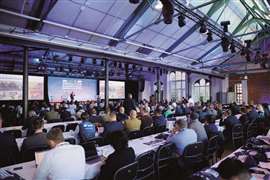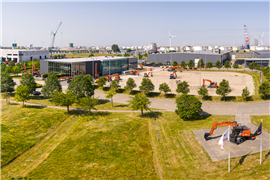Site-specific safety: when demolition meets live energy protocols
09 July 2025
Carrying out demolition works safely is always the top priority, but when those works are on an active site contractors can often find themselves subject to conflicting health & safety rules. And reconciling two such parallel systems can prove to be the biggest project challenge overall.
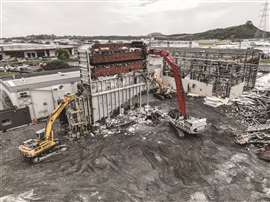 Demolition of the former Mercury Southdown Power Station in Auckland, New Zealand. (PHOTO: Ward)
Demolition of the former Mercury Southdown Power Station in Auckland, New Zealand. (PHOTO: Ward)
Stage 2 of the demolition of the former Mercury Southdown Power Station in Auckland, New Zealand, presented Ward Demolition with a high-risk environment, where extensive live infrastructure remained in operation throughout the works.
But beyond the technical demands of dismantling a power facility near major electrical assets, the project’s most significant safety challenge lay in reconciling two parallel systems of health and safety — one shaped by the needs of demolition, the other by the realities of power generation.
Rather than viewing those differences as incompatible, Ward approached the project as a chance to engage in detailed consultation with the client, working to find common ground where procedural requirements initially diverged. The result was a project that demonstrated not only rigorous safety planning, but also the value of open dialogue, cultural awareness, and mutual respect.
Led on site by Project Manager Jyoti Jain and Site Supervisor Bayleigh Ward, the team comprised more than 20 workers operating under Ward’s demolition procedures while working alongside energy sector protocols designed for live electrical environments.
The project was completed without health and safety incidents involving workers or the public — a direct outcome of the cooperation between both parties.
Two safety cultures, one shared objective
From the outset, the project required careful alignment between client-led protocols, built around active power station maintenance, and the realities of a decommissioned but still hazardous demolition environment. In some areas, this alignment was straightforward. In others, it demanded thoughtful negotiation.
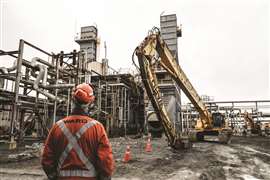 An early point of discussion on the project was the presence of machine spotters. (PHOTO: Ward)
An early point of discussion on the project was the presence of machine spotters. (PHOTO: Ward)
One early point of discussion was the use of machine spotters. While a standard requirement on live energy sites — where equipment such as EWPs or forklifts operate near energised assets — this approach posed challenges when applied directly to demolition operations.
Ward’s standard practice limits ground-based spotters around heavy plant to reduce the risk of accidental contact. Through a process of review and consultation, both teams agreed on a modified approach: spotters would be maintained where electrically relevant (e.g. for EWPs), but not routinely assigned to demolition excavators where doing so could increase on-ground exposure.
Another key area of collaboration was the handling of large structural elements. The client’s general policy against dropped loads reflected the risks of uncontrolled falling objects in operational power environments.
In contrast, controlled drops — into defined, barriered zones — are sometimes the safer option in demolition, reducing the risks associated with craning, rigging, or prolonged work at height. To accommodate both perspectives, the team worked through a case-by-case review of methods.
For example, while some components could be safely dropped using Ward’s typical approach, critical structures such as the boiler stacks and chimney were removed via crane and high-reach excavators to minimise vibration risk near active infrastructure.
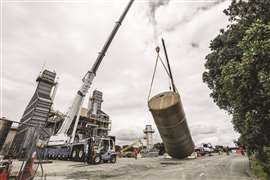 Ward and the client used a case-by-case method to decide which structures could be dropped and which had to be lowered by crane. (PHOTO: Ward)
Ward and the client used a case-by-case method to decide which structures could be dropped and which had to be lowered by crane. (PHOTO: Ward)
Adapting without compromising principles
Not all adjustments involved equipment or procedures — some involved clothing. The client’s arc-flash protection standard, designed for live electrical zones, required all personnel to wear 11 CAL arc-rated overalls.
During the winter months, Ward’s team complied fully. But as summer progressed and labour-intensive work increased, early signs of heat exhaustion and dehydration emerged.
After discussing the risks with the client, both parties agreed to adapt the requirement for areas where no live power was present. The solution — long-sleeve, high-visibility clothing better suited to the climate and task — allowed the demolition team to maintain safety and comfort without compromising overall risk management.
This willingness to adapt — on both sides — became a defining feature of the project. The client brought robust and well-established protocols. Ward brought demolition-specific experience and insight into risk behaviours unique to their industry. Rather than forcing one system to override the other, the project team built a hybrid approach tailored to the unique constraints of the site.
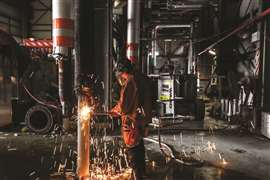 The correct PPE was essential for preventing heat exhaustion, fatigue and dehydration. (PHOTO: Ward)
The correct PPE was essential for preventing heat exhaustion, fatigue and dehydration. (PHOTO: Ward)
Support beyond the site perimeter
In parallel with these operational challenges, Ward recognised that worker wellbeing extended beyond physical safety.
During the course of the project, economic pressures associated with New Zealand’s cost of living crisis were having a visible impact across the construction sector — an industry already linked to the country’s highest rates of suicide.
Ward responded with practical, people-focused support. In addition to toolbox talks centred on mental health and help-seeking behaviour, the company increased the frequency of paid-for team lunches and provided direct support to staff members struggling to make ends meet.
Drawing on its farming roots, the company distributed meat packs and bulk produce to employees with larger families. These steps, though simple, helped reduce personal strain and reinforced the company’s view that safety includes emotional and financial wellbeing.
Safe outcomes, shared learning
Technical risks remained a constant feature throughout. At one stage, the team was required to demolish a structure within 3 metres of suspended 11kV live cables.
Overhead power lines and proximity to a live high-voltage switch yard created additional constraints across the entire work zone. Vibration monitoring, lift planning, exclusion zones, and communication protocols were all implemented to manage the hazards. Yet the success of the project — measured in its incident-free completion — was not due to technical controls alone. It came from the way both organisations engaged with one another.
As Ward stated in its project reflections, “Sometimes what’s safe for one profession isn’t necessarily the safest option in another.”
In managing the Southdown project, both client and contractor demonstrated that safety is not just a fixed standard to be enforced, but a collaborative practice that must respond to real conditions on the ground.
CONNECT WITH THE TEAM







